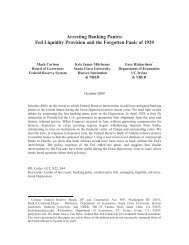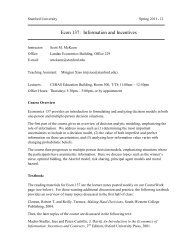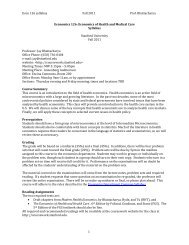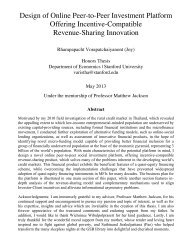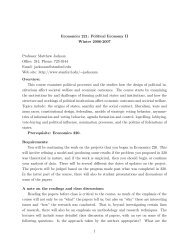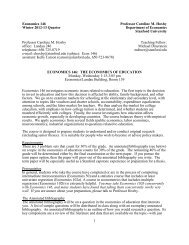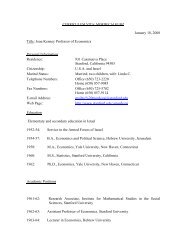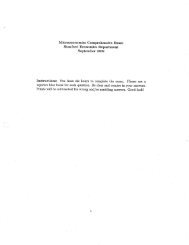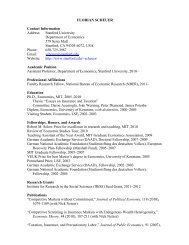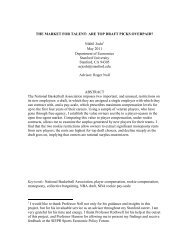Download - Economics - Stanford University
Download - Economics - Stanford University
Download - Economics - Stanford University
You also want an ePaper? Increase the reach of your titles
YUMPU automatically turns print PDFs into web optimized ePapers that Google loves.
ECON 214: TOPICS IN DEVELOPMENT ECONOMICS I<br />
1 General Information<br />
1.1 Outline<br />
Winter 2012<br />
PRELIMINARY SYLLABUS<br />
Giacomo De Giorgi<br />
<strong>Stanford</strong> <strong>University</strong><br />
Email: degiorgi@stanford.edu<br />
Office hours: Wednesday 11am-12.30pm<br />
Landau, Room 224<br />
The reading list includes several papers. The lectures, however, will focus on one or two of them,<br />
marked below by (*). The others constitute optional reading. There is no real textbook for this<br />
course. However, you will find several chapters of Debraj Ray’s book Development <strong>Economics</strong><br />
(Princeton <strong>University</strong> Press, 1998) a useful introduction to the topics (undergraduate level).<br />
Some chapters of Lars Ljungqvist and Tom Sargent’s book Recursive Macroeconomic Theory<br />
(MIT press 2004) are also very useful. These chapters are indicated in the reading list below.<br />
Bardhan and Udry (1999) covers a limited part of the course. Two newer books are rather<br />
interesting: 1. Poor <strong>Economics</strong> [Banerjee and Duflo (2011)] and More than Good Intentions<br />
[Karlan and Appel (2011)].<br />
The focus is on reading and understanding current empirical research in Development eco-<br />
nomics, while touching various formal modeling issues. Participation is key during lectures and<br />
I therefore expect you to have read the main papers for the class.<br />
I expect each student to present a paper of choice among a “feasible” set. Aside from the<br />
presentation the requirements are: either 1) a short paper (proposal) on a development topic<br />
of your choice, this can then be continued in the spring term with Prof. Dupas; or 2) three<br />
referee reports on assigned papers. Plus one problem set to be handed in.<br />
I would highly recommend option 1) since the paper might become an initial draft towards<br />
1
a second year paper and potentially a publishable piece of research. Further you can continue<br />
working on it in the spring quarter for Econ 215 with Prof. Dupas.<br />
The class grade is as follows: problem set (40%), referee reports (35%), class presentation of<br />
assigned paper (15%), class participation (10%). If you however decide to take the opportunity<br />
of writing a paper (proposal) that would count for 75% of the grade, while presentation and<br />
participation weigh 15% and 10% respectively.<br />
The schedule is tentative and as you will notice does not cover the 10 weeks of classes. This<br />
is because the precise timing of students’ presentations will have to be defined once we have<br />
the final class attendance.<br />
1.2 Timing of events<br />
OPTION 1): I expect you to come and see me by the end of week 3 to discuss some initial<br />
ideas. A preliminary research proposal should be prepared by the end of week 5. After that<br />
date you will have up to the end of the quarter to hand in your paper.<br />
OPTION 2): Problem set 1 will be posted on week 3 after Wednesday’s class and it is due on<br />
the following Wednesday. Referee reports are due on Wednesdays by the end of the class in<br />
week 5, 7 and 9. No late work will be graded.<br />
1.3 Other Policies<br />
The <strong>Economics</strong> Department has a common set of course management policies. These policies<br />
govern such matters as late work, missed examinations, and re-grading. If you are not familiar<br />
with these policies, make sure you read them carefully and familiarize yourself with them. They<br />
can be found at: http://www-econ.stanford.edu/academics/courses.html<br />
Students with Documented Disabilities: The Provost has asked instructors to include the follow-<br />
ing paragraph in the syllabus: Students who have a physical, psychological or learning disability<br />
that may necessitate an academic accommodation or the use of auxiliary aids and services in<br />
a class must initiate the request with the Student Disability Resource Center (SDRC). The<br />
SDRC will evaluate the request along with the required documentation, recommend appropri-<br />
ate accommodations, and prepare a verification letter dated in the current academic term in<br />
which the request is being made. Please contact the SDRC as soon as possible; timely notice<br />
is needed to arrange for appropriate accommodations. The SDRC is located at 563 Salvatierra<br />
Walk (Phone 723-1066).<br />
2
2 Reading List<br />
2.1 Consumption Smoothing and Insurance<br />
[WEEK 1]<br />
Chapter 15 of Ray (1998).<br />
Chapter 7 of Ljungqvist and Sargent (2000)<br />
(*) Townsend, R., (1994), “Risk and Insurance in Village India”, Econometrica, 62(3): 539-591.<br />
Fafchamps, M. and Lund, S., (2003), “Risk-sharing Networks in Rural Philippines”, Journal of<br />
Development <strong>Economics</strong>, 71(2): 261-87.<br />
Mazzocco, M. and Saini, S., (2011), “Testing Efficient Risk Sharing with Heterogeneous Risk<br />
Preferences,” forthcoming American Economic Review.<br />
Rosenzweig, M. (1988a), “Risk, Private Information, and the Family,” American Economic<br />
Review, 78(2): 245-50.<br />
Rosenzweig, M. (1988b), “Risk, Implicit Contracts and the Family in Rural Areas of Low-<br />
Income Countries”, The Economic Journal, 98(393): 1148-70.<br />
Townsend, R., (1995a), “Consumption Insurance: An Evaluation of Risk-Bearing Systems in<br />
Low-Income Economies”, The Journal of Economic Perspectives, 9(3): 83-102.<br />
Townsend, R., (1995b), “Financial Systems in Northern Thai Villages,” The Quarterly Journal<br />
of <strong>Economics</strong>, 110(4): 1011-46.<br />
Udry, C. (1994), “Risk and Insurance in a Rural Credit Market: An Empirical Investigation in<br />
Northern Nigeria,” Review of Economic Studies, 61(3): 495-526.<br />
Udry, C. (1995), “Risk and Saving in Northern Nigeria”, American Economic Review, 85(5):<br />
1287-1300.<br />
2.2 Lack of Enforceability and Imperfect Insurance<br />
[WEEK 2]<br />
Chapter 15 of Ljungqvist and Sargent (2004)<br />
(*) Coate, S. and Ravallion, M., (1993), “Reciprocity without Commitment,” Journal of De-<br />
velopment <strong>Economics</strong>, 40(1): 1-24.<br />
(*) Ligon, E., Thomas, J. and Worrall, T.,(2002), “Informal Insurance Arrangements in Village<br />
Economies,” Review of Economic Studies, 69(1): 209-44.<br />
Angelucci, M., De Giorgi, G. and Rasul, I., (2011), “Insurance and Investment within Family<br />
Networks,” mimeo <strong>Stanford</strong> <strong>University</strong>.<br />
3
Albarran, P. and Attanasio, P, (2002), “Empirical Implications of Imperfect Enforceability:<br />
Evidence from Mexican Villages”, UCL Mimeo.<br />
Attanasio, P. and Rios Rull, V., (2000a), “Consumption Smoothing in Island Economies: Can<br />
Public Insurance Reduce Welfare?” European Economic Review, 44(7): 1225-58.<br />
Kehoe, P. and Perri, F., (2004), “Competitive Equilibria with Limited Enforcement”, Journal<br />
of Economic Theory, 119(1): 184-206.<br />
Kocherlakota, N., (1996), “Implications of efficient risk sharing without commitment,” Review<br />
of Economic Studies, 63: 595-609.<br />
2.3 Social Networks and Informal Institutions<br />
[WEEK 3]<br />
(*) Banerjee, A. and Newman, A., (1998), “Information, the Dual Economy, and Development,”<br />
Review of Economic Studies, 65(4): 631-53.<br />
(*) Munshi, K., (2003), “Networks in the Modern Economy: Mexican Migrants in the U. S.<br />
Labor Market,” The Quarterly Journal of <strong>Economics</strong>, 118(2): 549-97.<br />
(*) Knack, S. and Keefer, P., (1997), “Does Social Capital have an Economic Payoff? A Cross-<br />
Country Investigation,” The Quarterly Journal of <strong>Economics</strong>, 112(4): 1251-88.<br />
Bramoullé, Y. and Kranton, R., (2007a), “Risk Sharing Across Communities,” American Eco-<br />
nomic Review Papers and Proceedings, 97 (2), pp. 70-74.<br />
Bramoullé, Y. and Kranton, R., (2007b), “Risk Sharing Networks,” Journal of Economic Be-<br />
havior and Organization, 64 (3-4): 275-94.<br />
Genicot, G. and Ray, D., “Group Formation in Risk-Sharing Arrangements,” Review of Eco-<br />
nomic Studies, 70(1): 87-113.<br />
Greif, A. (1993): “Contract enforceability and economic institutions in early trade: the Maghribi<br />
Trader’s coalitions,” American Economic Review, 83(3): 525-48.<br />
Narayan, D. and Pritchett, L., (1997), “Cents and Sociability: Household Income and Social<br />
Capital in Rural Tanzania,” World Bank Policy Research Working Paper No. 1796.<br />
Durlauf, S. and Fafchamps, M., (2005), “Social Capital,” in Handbook of Economic Growth,<br />
Volume 1B, Ch. 26, Steven Durlauf and Philippe Aghion (eds.)<br />
2.4 Program Evaluation<br />
[WEEK 4]<br />
This part will be mostly based on lecture notes.<br />
4
Blundell, R. and Costa-Dias, M., (2000), “Evaluation Methods for Non-Experimental Data,”<br />
Fiscal Studies, 21(4): 427-68.<br />
Duflo, E., Glennerster, R. and Kremer, M., (2007), “Using Randomization in Development<br />
<strong>Economics</strong> Research: A Toolkit,” CEPR DP: 6059.<br />
Heckman, J., Lalonde, R. and Smith, J., (1999), “The <strong>Economics</strong> and Econometrics of Active<br />
Labor Market Programs,” Handbook of Labor <strong>Economics</strong>, Volume 3, Ashenfelter, A. and D.<br />
Card, eds., Amsterdam: Elsevier Science.<br />
Ravallion, M.,“The Mystery of the Vanishing Benefits: Ms Speedy Analysts Introduction to<br />
Evaluation ,” World Bank WP: 2153.<br />
2.5 Joint Liability and Micro-Credit<br />
[WEEK 5 and 6]<br />
(*) Burgess, R. And Pande, R., (2005), “Can Rural Banks Reduce Poverty? Evidence from the<br />
Indian Social Banking Experiment,” American Economic Review, 95(3): 780-95.<br />
(*) Ghatak, M. and Guinnane, T., (1999), “The <strong>Economics</strong> of Lending with Joint Liability :<br />
Theory and Practice,” Journal of Development <strong>Economics</strong>, 60(1): 195-228.<br />
(*) Giné, X. and Karlan, D., Peer Monitoring and Enforcement: Long Term Evidence from<br />
Microcredit Lending Groups with and without Group Liability (January 2008)<br />
de Mel, S., McKenzie, D. and Woodruff, C., (2008), “Are Women More Credit Constrained?<br />
Experimental Evidence on Gender and Microenterprise Returns,” World Bank WP: 4746.<br />
Karlan, D. and Zinman, J., (2007), “Observing Unobservables: Identifying Information Asym-<br />
metries with a Consumer Credit Field Experiment,” mimeo Yale.<br />
Banerjee, A., Duflo, E. and Munshi, K., (2003), “The (mis)-allocation of capital,” Journal of<br />
European Economic Association, Papers and Proceedings: 484-94.<br />
Ghosh, P., Mookherjee, D. and Ray, D., ‘Credit Rationing in Developing Countries: An<br />
Overview of the Theory,” by, Chapter 11 in Readings in the Theory of Economic Develop-<br />
ment, edited by D. Mookherjee and D. Ray, London: Blackwell, 2000.<br />
Karlan, D., (2007), “Social Connections and Group Banking,” Economic Journal, 117: F52-F84.<br />
Morduch, Jonathan (1999), “The Microfinance Promise,” Journal of Economic Literature,<br />
37(4): 1569-1614.<br />
Pitt, M. and Khandker, S., (1998), “The Impact of Group-based Credit Programs on Poor<br />
Households in Bangladesh: Does the Gender of Participants Matter?,” Journal of Political<br />
Economy, 106(5): 958-96.<br />
5
2.6 Institutions and the Process of Development<br />
[WEEK 7]<br />
(*) Acemoglu, D., Johnson, S. and Robinson, J., (2001), “The colonial origins of comparative<br />
development: An empirical investigation,” American Economic Review, 91(5): 1369-1401.<br />
(*) Hall, R. and Jones, C., (1999), “Why do some countries produce so much more output per<br />
worker than others?,” Quarterly Journal of <strong>Economics</strong>, 114(1), 83-116.<br />
Acemoglu, D., Johnson, S. and Robinson, J., (2002), “Reversal of fortune: Geography and<br />
institutions in the making of the modern world income distribution,” The Quarterly Journal of<br />
<strong>Economics</strong>, 117(4): 1231-94.<br />
Greif, A., (2006), “Institutions and the Path to the Modern Economy: Lessons from Medieval<br />
Trade,” Cambridge <strong>University</strong> Press.<br />
Pande, R. and Udry, C., (2005), “Institutions and Development: A View from Below,” in the<br />
Proceedings of the 9th World Congress of the Econometric Society, edited by R. Blundell, W.<br />
Newey, and T. Persson, Cambridge <strong>University</strong> Press, 2005<br />
2.7 Climate and the Process of Development<br />
[WEEK 8]<br />
As this is a “hot” topic of active research we will update the reading list as we go.<br />
(*) Dell, Jones and Olken, (2009), Climate Shocks and Economic Growth: Evidence from<br />
the Last Half Century, NBER WP<br />
Deschenes, O. and Greenstone, M., Climate Change, Mortality, and Adaptation, Evidence<br />
from Annual Fluctuation in Weather in the US, NBER Working Paper 13178<br />
Burgess, R., Deschenes, O., Donaldson, D. and Greenstone, M., Weather and Death in<br />
India: Mechanisms and Implications of Climate Change, in progress<br />
Felkner, J., Tazhibayeva, K. and Townsend, R.. 2009. “Impact of Climate Change on Rice<br />
Production in Thailand,” American Economic Review, P&P, 99(2): 20510.<br />
2.8 Papers for Students’ Presentation and Reports<br />
The list below is preliminary as we will add a few more papers depending on demand and<br />
interests at a later stage.<br />
[WEEK 5]<br />
6
Mazzocco, M. and Saini, S., (2011), “Testing Efficient Risk Sharing with Heterogeneous Risk<br />
Preferences,” forthcoming the American Economic Review.<br />
Kinnan, C., (2011), “Distinguishing barriers to insurance in Thai villages,” mimeo Northwestern<br />
[WEEK 7]<br />
Beaman, L., (2011), “Social Networks and the Dynamics of Labor Market Outcomes: Evidence<br />
from Refugees Resettled in the U.S,” Forthcoming, Review of Economic Studies.<br />
Kinnan, C. and Townsend, R., (2011), “Kinship and Financial Networks, Formal Financial<br />
Access and Risk Reduction,” mimeo MIT<br />
[WEEK 9]<br />
Jensen, R., (2000), “Agricultural Volatility and Investment in Children,” the American Eco-<br />
nomic Review, 90(2)<br />
7



